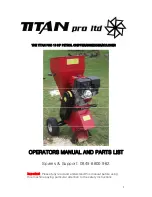
39
15.5 - leak detection
Never use oxygen or dry air, as this would cause a risk of
fire or explosion.
•
Carry out a leak detection test on the whole system
using the following methods: pressure test using
dehydrated nitrogen or a mixture of nitrogen and
refrigerant used for the system, helium leak test.
•
Connect the compressor to the system by opening the
valves.
• The duration of the test must be sufficient to guaran-
tee the absence of very small leaks in the circuit.
• Use specific tools, designed for leak detection.
•
The low-pressure side test pressure must not exceed
pressure Ps indicated on the compressor and unit
name plates.
• If there is a leak, repair it and carry out the leak
detec-tion test again.
15.6 - Evacuation
To evacuate the system, observe the following recommen-
dations:
Connect the vacuum pump to the high (HP) and low-
pressure (LP) side for evacuation of the complete circuit.
All units are equipped with valves with 3/8” SAE connec-
tions on the suction and liquid lines, permitting the connec-
tion of large-diameter flexible pipes limiting the pressure
drops for the evacuation.
1. The vacuum level achieved must be 0.67 mbar (500 µm
Hg).
2. Wait 30 minutes.
3. If the pressure increases rapidly, the system ist not
leak-tight. Localise and repair the leaks.
Restart the evacuation procedure and repeat steps 1, 2
etc.
4. If the pressure increeases slowly, this indicates that
moisture is present inside the system. Break the vacuum
with nitrogen and restart the evacuation procedure
(steps 1, 2 etc.).
5. Repeat the evacuation procedure (steps 1, 2); a vacuum
level of 0.67 mbar (500 µm Hg) must be achieved and
maintained for four hours.
This vacuum level must be measured at one of the system
connections and not at the vacuum pump pressure
gauge.
ATTENTION: Do not use a megohmmeter and do not
place any stress on the compressor motor when the system
has been ecacuated. There is a risk of internal short circuits
between the motor windings.
Do not use additives for leak detection. Do not use CFCs/
hCFCs as tracer fluids for leak detection.
15.7 - Recharging liquid refrigerant
CAUTION: 30RW units are charged with liquid hFC-
407C refrigerant.
This non-azeotropic refrigerant blend consists of 23% R-32,
25% of R-125 and 52% R-134a, and is characterised by
the fact that at the time of the change in state the tempera-
ture of the liquid/vapour mixture is not constant, as with
azeotropic refrigerants. All checks must be pressure tests,
and the appropriate pressure/temperature ratio table must
be used to determine the corresponding saturated tempe-
ratures (saturated bubble point curve or saturated dew
point curve).
Leak detection is especially important for units charged
with refrigerant R-407C. Depending on whether the leak
occurs in the liquid or in the vapour phase, the proportion
of the different components in the remaining liquid is not
the same.
NOTE: Regularly carry out leak checks and immediately
repair any leak found.
15.8 - Characteristics of R-407C
See the table on the next page.
Saturated bubble point temperatures (bubble point curve)
Saturated dew point temperatures (dew point curve)
15.9 - Electrical maintenance
When working on the unit comply with all safety precau-
tions described in section 1.3.
It is strongly recommended to change the unit fuses every
15000 operating hours or every three years.
It is recommended to verify that all electrical connections
are tight:
•
after the unit has been received at the moment of
installation and before the first start-up,
•
one month after the first start-up,when the electrical
components have reached their nominal operating
temperatures,
•
then regularly once a year.






































